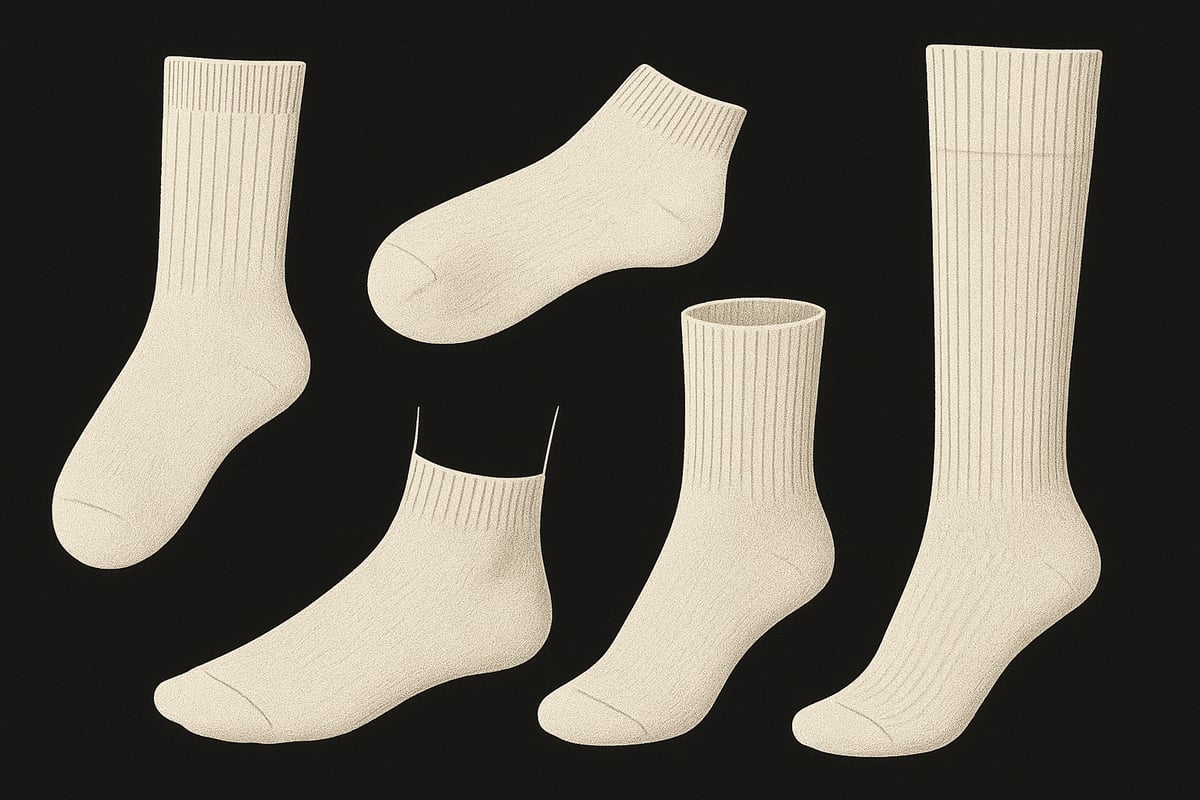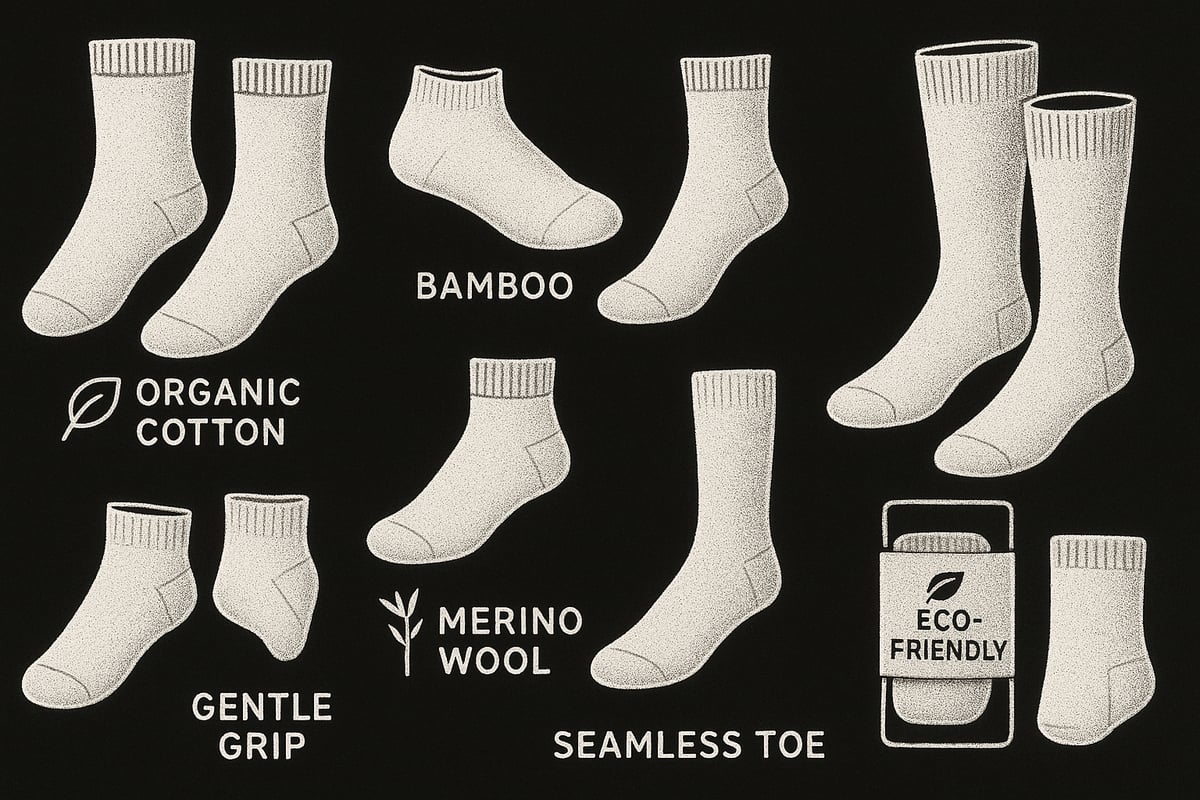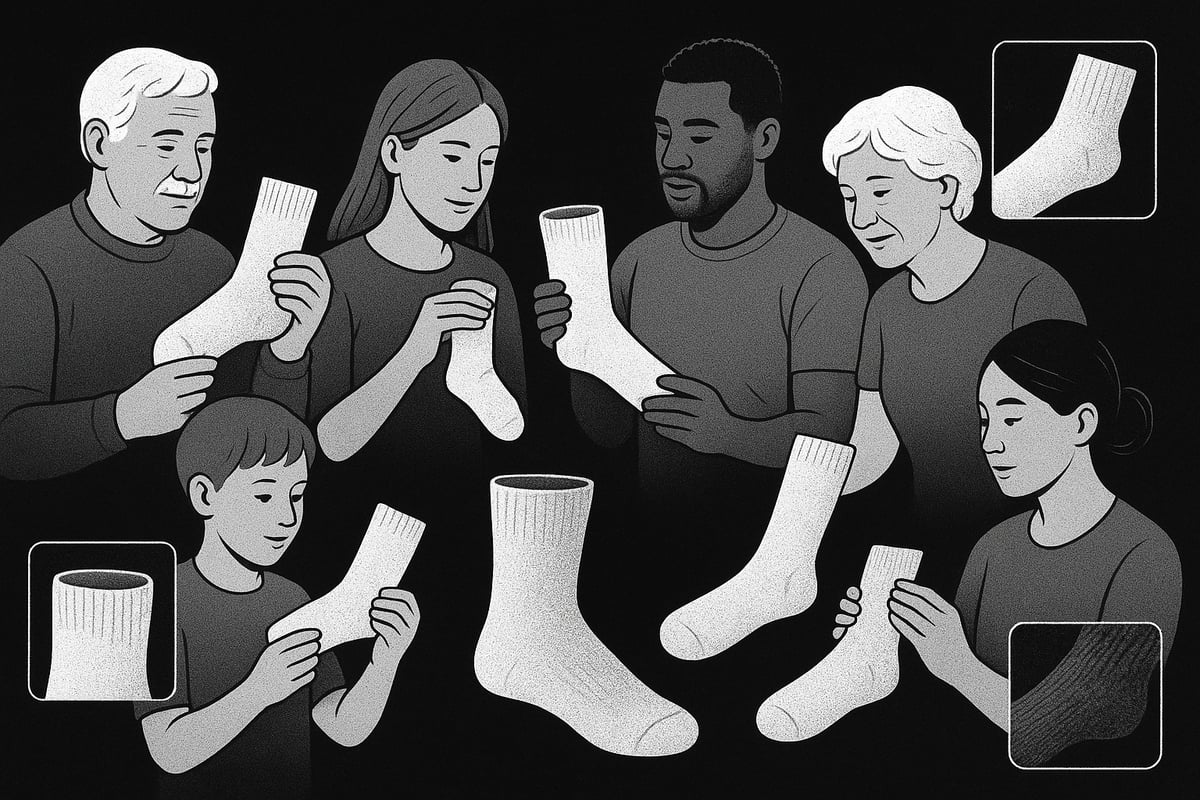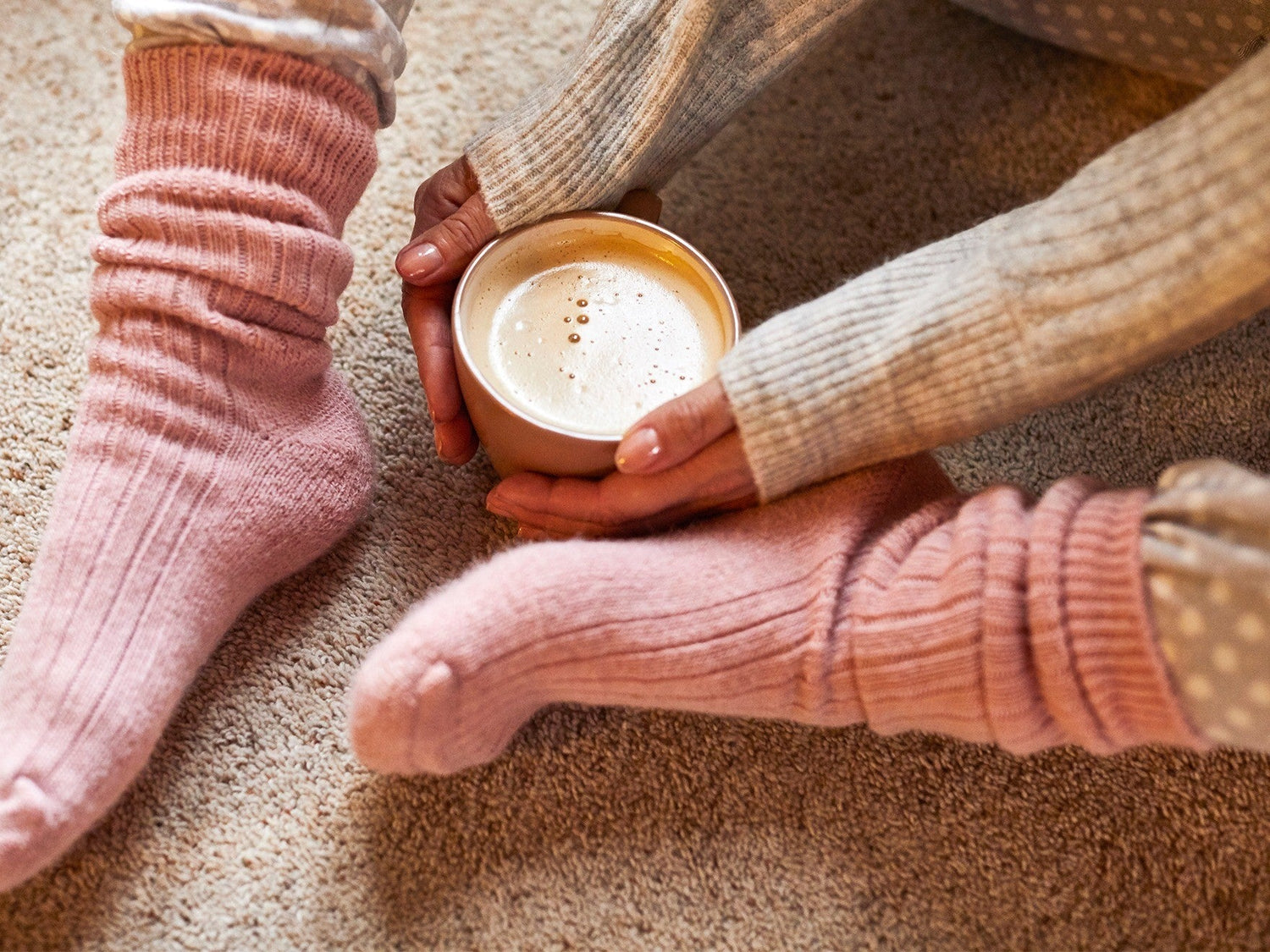
Elastic Free Socks Guide: Comfort Without Compromise 2025
Are your socks leaving painful marks or causing discomfort by the end of the day? You’re not alone. Many people deal with the frustration of tight, elasticated socks, which is why the demand for alternatives is growing.
Elastic free socks are designed for all-day comfort, offering a stylish and healthy option without any compromise. This guide will walk you through everything you need to know about elastic free socks in 2025.
We’ll explore what makes these socks unique, their benefits, who should wear them, the latest material innovations, top brands, care tips, and the best places to buy your next pair.
What Are Elastic Free Socks?
If you’ve ever peeled off a pair of socks to find deep marks on your skin, you’re not alone. The discomfort caused by tight elastic bands is a common frustration, leading many to seek out elastic free socks for relief. But what exactly sets these socks apart, and why are they gaining traction in 2025?

Definition and Key Features
Elastic free socks are designed without the synthetic elastic bands found in most traditional socks. Instead, they rely on natural stretch and innovative construction for a secure yet non-constricting fit. This approach eliminates the tight grip that can leave marks or restrict circulation, making elastic free socks a top choice for all-day comfort.
Key features include ribbed or gently woven cuffs that hold the socks in place without squeezing. Many elastic free socks also feature seamless toes, further reducing irritation. Unlike regular socks, which often use elastic or spandex to create stretch, these socks use advanced knitting techniques and carefully selected fibers to achieve flexibility.
Materials play a major role in the comfort and function of elastic free socks. Organic cotton, bamboo, and merino wool are among the most popular options, prized for their breathability, softness, and hypoallergenic qualities. For example, Rawganique offers 100% organic cotton socks, while EcoChoices focuses on latex-free, chemical-free alternatives.
There’s a common misconception that elastic free socks are loose or saggy. In reality, modern designs ensure these socks stay up comfortably, thanks to clever engineering rather than tight bands. This rise in popularity is fueled by growing awareness of skin sensitivities, allergies, and the desire for daily comfort.
If you’re searching for practical examples, collections like the Soft top sock collection showcase gentle grip and soft top socks that embody the best features of elastic free socks.
Types of Elastic Free Socks
The world of elastic free socks is more diverse than ever in 2025. You’ll find classic crew socks, practical ankle socks, cozy knee-highs, dress socks for formal wear, and ultra-soft bed socks for nighttime comfort.
Special categories cater to unique needs. Diabetic socks are crafted with extra care to avoid constriction, while sensitive skin and allergy-friendly options use only the purest materials. Allergy sufferers, in particular, benefit from socks free of latex, polyester, or harsh chemicals.
Elastic free socks are designed for everyone—men, women, children, and even babies. Brands like Rawganique offer a broad range of sizes and organic cotton color choices, making it easy to find a pair that fits your style and needs.
Design variety is also a hallmark of elastic free socks in 2025. From bold colors and playful patterns to understated neutrals, there’s truly something for every preference. Whether you need socks for work, relaxation, or outdoor adventures, elastic free socks deliver comfort and style without compromise.
Health and Comfort Benefits of Elastic Free Socks
Do you ever feel relief when peeling off your socks at the end of a long day? If so, you’re not alone. Many people experience discomfort, tightness, or even skin marks from traditional socks. That’s where elastic free socks come in, offering a blend of comfort and health benefits that can transform your daily routine. Let’s explore why these socks are a game-changer for so many people in 2025.

Improved Circulation and Reduced Pressure
One of the standout benefits of elastic free socks is their ability to prevent constriction around your legs. Unlike traditional socks with tight elastic bands, these socks use gentle grip technology or ribbed cuffs to stay up without squeezing. This design helps maintain healthy blood flow, reducing the risk of red marks, indentations, or discomfort after hours of wear.
For individuals with diabetes, edema, or circulatory issues, non-binding socks can be a vital part of daily care. Medical professionals often recommend elastic free socks to avoid pressure that can lead to skin breakdown or ulcers. In fact, a systematic review found that protective socks significantly reduce foot pressure and help prevent complications in diabetic patients.
Statistics show that over 60% of adults have experienced sock marks or discomfort from elasticated socks at some point. Brands now offer diabetic-friendly options that prioritize both comfort and health. This makes elastic free socks a smart choice for anyone seeking better circulation and less pressure on their legs.
Skin Health and Allergy Reduction
If you have sensitive skin, eczema, or allergies, elastic free socks can make a real difference. The absence of synthetic elastic and latex means fewer irritants in contact with your skin. Many brands, like EcoChoices, craft their socks from organic cotton or bamboo, ensuring they are hypoallergenic and chemical-free.
Latex and synthetic fibers in regular socks can trigger itchiness or rashes for some people. With elastic free socks, you benefit from natural fibers that are gentle on delicate skin. This is especially important for those with medical conditions or children whose skin is more prone to irritation.
EcoChoices offers latex-free and chemical-free options, catering specifically to individuals with allergies. These socks are also a popular choice among people who want to avoid harsh dyes or processing chemicals. Choosing elastic free socks is a proactive step toward healthier, happier skin.
Enhanced All-Day Comfort
Comfort is at the core of why so many people switch to elastic free socks. Modern designs eliminate issues like rolling, pinching, or sagging. Instead, you get a secure yet gentle fit that stays in place throughout the day.
Natural fibers such as organic cotton, merino wool, and bamboo wick away moisture, regulate temperature, and help prevent odor. This means your feet stay dry and fresh, even during long hours or active days. Customers frequently praise brands like Rawganique for their soft, breathable socks that deliver lasting comfort.
No more distractions from tight bands or seams digging into your skin. Elastic free socks are engineered to provide a smooth, irritation-free experience. Whether you’re relaxing at home or on your feet at work, you’ll notice the difference from the first wear.
Suitability for All Lifestyles
Elastic free socks are designed for everyone, regardless of age, gender, or activity level. They are ideal for office workers, teachers, healthcare professionals, and anyone who spends long hours standing or walking. Parents increasingly choose these socks for their children to avoid sock marks and discomfort during school or play.
Outdoor enthusiasts and athletes also benefit from elastic free socks, as natural fibers offer excellent breathability and moisture management. Whether you’re hiking, running, or enjoying a leisurely walk, these socks help keep your feet healthy and comfortable.
Available in a wide range of styles and colors, elastic free socks fit seamlessly into any wardrobe. From dress socks to cozy bed socks, there’s a pair for every occasion. With so many options in 2025, finding your perfect match is easier than ever.
Materials and Innovations in Elastic Free Socks (2025)
If you are wondering what sets elastic free socks apart in 2025, it all starts with the materials and technology behind them. The latest elastic free socks use thoughtfully chosen fibers and advanced construction methods to deliver comfort, support, and sustainability for every wearer.

Natural Fiber Advancements
The foundation of modern elastic free socks lies in the use of premium natural fibers. Organic cotton remains a top choice, offering breathability and a soft feel against the skin. Merino wool is another favorite due to its superior temperature regulation and moisture-wicking abilities, making these socks suitable for all seasons. Bamboo is also gaining ground, thanks to its hypoallergenic and antimicrobial properties. Many brands now highlight their commitment to biodegradable and organic materials, as seen in Rawganique and EcoChoices collections.
A quick comparison of popular natural fibers:
| Material | Key Benefits | Eco-Friendly? |
|---|---|---|
| Organic Cotton | Soft, breathable, gentle on skin | Yes |
| Merino Wool | Moisture-wicking, regulates temp | Yes |
| Bamboo | Hypoallergenic, antimicrobial | Yes |
These advancements ensure elastic free socks provide comfort without the irritation of synthetic fibers.
Modern Manufacturing Techniques
Innovations in construction have transformed how elastic free socks fit and feel. Seamless toe technology eliminates the bulky seams that cause discomfort, while gentle grip cuffs use ribbed or honeycomb weaves to secure socks without tightness. Brands are also moving toward dye-free and chemical-free processes, which make these socks a safe choice for sensitive skin.
Modern techniques mean your elastic free socks stay up and in place, without pinching or rolling. If you are curious about the health and comfort benefits, Why choose our socks offers more insight into the difference these innovations make for your feet.
Sustainability and Environmental Impact
As consumers become more eco-conscious, the demand for sustainable elastic free socks is soaring. Biodegradable fibers help reduce landfill waste, while recyclable and compostable packaging is becoming the norm. Certifications such as GOTS and OEKO-TEX give added assurance that your socks are free from harmful chemicals and produced responsibly.
Choosing elastic free socks made from organic materials is a simple way to lower your environmental footprint. Brands like Rawganique and EcoChoices are leading the charge by prioritizing both comfort and planet-friendly practices.
Durability and Longevity
Durability is no longer a compromise for those seeking elastic free socks. Advances in natural fiber blends mean socks are built to last, even after frequent washes. Reinforced heels and toes, along with careful construction, prevent sagging and premature wear.
To get the most from your elastic free socks, look for quality craftsmanship and follow care instructions closely. With proper upkeep, you will enjoy long-lasting comfort and support, making them a worthwhile investment for your wardrobe.
How to Choose the Best Elastic Free Socks for You
Finding the perfect elastic free socks means focusing on comfort, fit, and your unique needs. With so many options in 2025, making the right choice can feel overwhelming. Let’s break it down step by step so you can enjoy comfort without compromise.

Assessing Your Needs
Start by identifying why you want elastic free socks. Do you have sensitive skin, diabetes, or simply dislike tight cuffs? Maybe you’re looking for socks your child can wear all day without red marks. List your top priorities, such as breathability, hypoallergenic materials, or all-day comfort.
Sizing is crucial. Elastic free socks fit differently than regular socks because they rely on natural stretch and gentle cuffs. For help finding your best fit, check out this Sock size and fit guide. Consider your daily activities too. Office workers, athletes, and those at home may want different sock styles.
Key Features to Look For
When shopping for elastic free socks, focus on the material. Look for organic cotton, bamboo, or merino wool as they offer softness and breathability. Construction details also matter. Seek out seamless toes for irritation-free wear and gentle cuffs that stay in place without squeezing.
Certifications like GOTS or OEKO-TEX signal that socks are free from harmful chemicals. Allergy-friendly labels are helpful if you have sensitivities. Reinforced heels and toes add durability, making your elastic free socks a smart investment.
Comparison Table: Key Features
| Feature | Why It Matters |
|---|---|
| Organic Cotton | Soft, breathable, sustainable |
| Seamless Toe | Reduces friction, irritation |
| Gentle Cuff | Prevents marks, stays up |
| Certified Materials | Allergy and eco safe |
Trying and Testing
Before committing to a brand, try a few pairs to see what works for you. Each person’s needs and preferences are unique, so don’t hesitate to experiment. Read customer reviews for insights on fit and comfort.
Many brands offer satisfaction guarantees or easy return policies. Take advantage of these to find elastic free socks that truly fit your feet and lifestyle. Testing at home lets you gauge comfort during daily wear, from morning to night.
Price vs. Value
Elastic free socks typically range from £15 to £30 per pair. While they may cost more upfront than standard socks, they often last longer thanks to quality materials and construction. Think of them as an investment in your foot health and daily comfort.
Consider the long-term value. Durable socks mean fewer replacements over time, saving you money and reducing waste. Prioritize comfort and longevity when making your choice, and remember that the right pair of elastic free socks can make a world of difference.
Care and Maintenance Tips for Elastic Free Socks
Keeping your elastic free socks in top shape is simple with the right care routine. A little attention goes a long way in preserving comfort, fit, and longevity. Let’s break down the best ways to wash, store, repair, and maximize the life of your favorite pairs.
Washing and Drying Best Practices
Elastic free socks often use natural fibers like cotton, bamboo, or wool, making gentle washing crucial. Always turn socks inside out before washing. Use cold or lukewarm water with a mild, fragrance-free detergent. Avoid fabric softeners, which can coat fibers and reduce breathability.
For best results, air dry your socks flat rather than using a tumble dryer. High heat can weaken fibers and cause shrinkage. For more details on caring for natural fiber socks, check out Caring for your alpaca and mohair socks.
Storage and Handling
Proper storage helps elastic free socks keep their shape and softness. Fold socks gently instead of rolling them tightly. Store in a cool, dry drawer away from direct sunlight to prevent fading and fiber breakdown.
Avoid stretching the cuffs when putting on or taking off your socks. For pairs with special features, such as seamless toes, align them carefully to prevent stress on the stitching. Regularly rotating your socks can also help distribute wear evenly.
Repair and Upcycling
Don’t toss out your elastic free socks at the first sign of a hole. Mending is easy with a needle and matching thread. Use a simple whip stitch or darning technique to close small holes, especially in the toe or heel area.
If socks become too worn for repair, consider upcycling. Old socks are perfect for dusting, cleaning, or even crafting small pouches. This sustainable approach extends the usefulness of your socks and reduces waste.
Maximizing Sock Lifespan
Want your elastic free socks to last? Rotate multiple pairs to minimize daily wear. This gives each pair time to recover its shape between uses. Keep an eye out for thinning areas and reinforce them early with a few stitches.
Choose gentle laundry cycles and avoid harsh chemicals. If socks lose their softness, a vinegar rinse can help restore fibers. Investing in higher quality socks may cost more upfront but pays off with longer-lasting comfort.
Troubleshooting Common Issues
If you notice your elastic free socks slipping or sagging, try washing them in cooler water and reshaping while damp. Persistent odor can be tackled with a natural fiber-friendly wash and thorough air drying.
For pilling, gently remove fuzz with a fabric shaver or your hands. If socks shrink slightly, stretch them gently while damp. Regular care helps prevent most problems, ensuring your elastic free socks stay comfortable and reliable.


